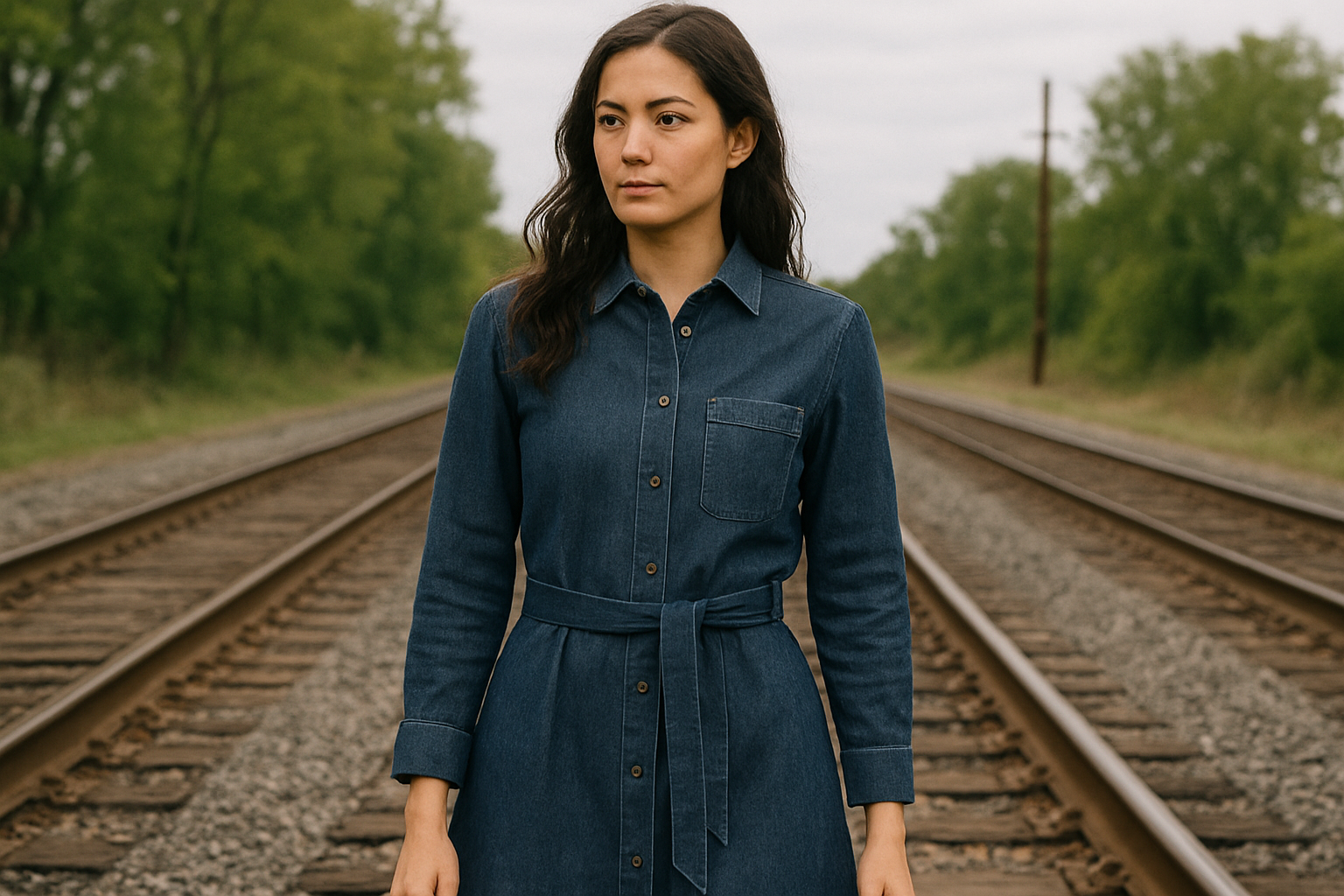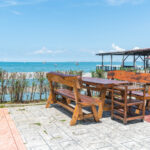In a fashion landscape that constantly evolves, certain styles have a way of returning to the spotlight with fresh relevance. One such revival is the railroad dress — a piece rooted in history yet reimagined for the modern wardrobe. Defined by its distinctive vertical stripes and workwear heritage, the railroad dress blends practicality with effortless elegance. Its name stems from the railroad stripe fabric, a material once used for the uniforms of railroad workers and engineers in the late 19th and early 20th centuries.
Today, this humble fabric has transformed into a fashion-forward choice, appreciated by designers and style enthusiasts alike. Its enduring appeal lies in its simplicity, versatility, and rich backstory. For fashion lovers and trend readers, understanding the railroad dress means appreciating the seamless fusion of historical utility and contemporary style — a story that continues to unfold on runways, in boutiques, and on city streets around the world.
What Is a Railroad Dress and Where Did It Come From
At its core, a railroad dress is a garment crafted from railroad stripe fabric — a tightly woven cotton or denim with narrow, usually vertical stripes in contrasting shades (often indigo and white). The fabric itself has utilitarian origins: it was first used for the overalls, jackets, and workwear uniforms of 19th-century railroad engineers and conductors in the United States. The stripes were not just aesthetic; they served a purpose. The dense weave offered durability against harsh conditions, while the fine stripes helped conceal dirt and wear from daily labor.
The term “railroad” became synonymous with this particular stripe pattern, and over time, the fabric transitioned beyond industrial use. Workwear has always influenced fashion — from denim jeans to chore coats — and the railroad stripe is no exception. As fashion designers began exploring heritage fabrics in the mid-20th century, the once purely functional material found new life in casual wear, accessories, and eventually dresses.
The railroad dress embodies this evolution. It is not defined by a specific cut or silhouette but rather by the signature fabric and its historical connection. From classic shirt dresses and pinafores to contemporary wrap styles and maxi lengths, the railroad dress is both a nod to the past and a reflection of modern design sensibilities.
The Signature Look – Fabric, Stripes, and Classic Details
The unmistakable hallmark of a railroad dress is its striped fabric. Traditionally, these stripes are thin and vertical, alternating between dark navy or black and white. This pattern — also known as hickory stripe — gives the dress a clean, elongated look, flattering most body types by creating the illusion of height and a streamlined silhouette.
The fabric is typically cotton twill or denim, chosen for its durability and breathability. Some modern iterations incorporate lighter weaves, blends, or even seersucker-inspired textures to add comfort and movement, especially for warm-weather collections.
Beyond the fabric, the details complete the signature style. Many railroad dresses feature button-down fronts, a nod to traditional workwear shirts, or utility-inspired pockets that blend form and function. Stitching is often highlighted in contrast thread, another subtle reference to the garment’s workwear roots. Even when adapted into more refined silhouettes — such as belted midi dresses or tailored shirt dresses — these touches maintain the dress’s connection to its practical origins.
Color remains central to the look. While indigo and white remain the classic palette, modern designers have experimented with softer neutrals, muted pastels, and bold reinterpretations that retain the essence of the stripe while pushing the aesthetic forward.
From Rails to Runway – The Evolution of Railroad Dresses in Fashion
The journey of the railroad dress from industrial workwear to high-fashion statement reflects a broader story within fashion: the transformation of utility into style. In the early 20th century, workwear began to influence mainstream fashion as durability and functionality gained cultural appeal. Denim, once purely a laborer’s fabric, became a cornerstone of casualwear — and railroad stripes followed a similar path.
By the mid-20th century, designers started incorporating hickory stripe fabric into casual shirts and jackets. It wasn’t long before dresses followed, offering women a way to embrace the workwear trend without sacrificing femininity. The 1970s and 1980s saw vintage-inspired fashion bring railroad stripes back into vogue, often styled with denim jackets or layered with knitwear for a relaxed yet chic look.
In recent years, the heritage workwear revival has brought renewed attention to the railroad dress. Contemporary brands and high-end labels alike have embraced the style, reinterpreting it with luxurious fabrics, modern tailoring, and bold silhouettes. On runways, railroad dresses appear alongside denim and canvas pieces, highlighting a return to authenticity and craftsmanship. In street style, influencers and fashion enthusiasts celebrate the dress for its versatility — a bridge between casual utility and polished sophistication.
The modern railroad dress is not just a garment; it is a statement about fashion’s cyclical nature and its ability to transform the functional into the fashionable.
Popular Styles and Variations of Railroad Dresses Today
Today’s railroad dresses come in a range of styles, each blending classic elements with contemporary trends. The shirt dress remains a perennial favorite — structured yet relaxed, often belted at the waist to create a flattering silhouette. Its button-front design echoes traditional work shirts while offering endless styling options.
The pinafore dress is another popular variation, often layered over t-shirts or blouses for a casual yet polished look. This style leans into the vintage charm of railroad fabric while remaining practical for everyday wear. Wrap dresses and smocked silhouettes have also emerged, offering softer, more feminine interpretations that balance the fabric’s rugged origins with modern elegance.
Maxi and midi lengths dominate current collections, reflecting the broader shift toward versatile, wearable pieces. Designers play with stripe orientation — mixing vertical and diagonal patterns — to add visual interest and contemporary flair. Some incorporate unexpected details such as ruffles, cut-outs, or asymmetrical hems, proving that even a fabric with industrial roots can adapt to high-fashion experimentation.
Despite these variations, the essence of the railroad dress remains consistent: timeless stripes, quality fabric, and a subtle nod to its utilitarian past.
How to Style a Railroad Dress for Effortless Everyday Outfits?
Styling a railroad dress is all about balance — blending its workwear heritage with modern touches. For an easy daytime look, pair a classic shirt-style railroad dress with white sneakers and minimal accessories. The vertical stripes do most of the talking, so simplicity often creates the most polished result.
To elevate the dress for a smart-casual outfit, swap sneakers for leather ankle boots and add a structured blazer. A belt can help define the waist and introduce a touch of contrast, while a crossbody bag keeps the look cohesive and chic.
In warmer months, lightweight railroad dresses pair beautifully with sandals, straw hats, and woven totes, capturing an effortless summer vibe. For cooler weather, layering is key: a turtleneck beneath the dress or a cropped sweater over it creates depth and dimension without overshadowing the signature stripes.
Accessories should complement rather than compete with the pattern. Neutral tones and classic pieces — such as gold hoop earrings, leather belts, or understated scarves — work best. Because the railroad dress itself carries historical weight and visual interest, keeping the rest of the outfit clean allows its character to shine.
Buying Guide – What to Look for When Choosing a Quality Railroad Dress?
When investing in a railroad dress, fabric quality should be your first consideration. Authentic railroad stripe fabric is typically cotton twill or denim, known for its durability and structure. Lighter weaves can offer comfort for warmer climates but should still feel substantial and well-constructed.
Pay attention to stripe alignment, especially at seams and hems. Misaligned stripes can disrupt the visual flow of the dress and signal lower craftsmanship. Buttonholes, stitching, and pocket placement are additional details that reveal the quality of construction.
Fit is another essential factor. Because vertical stripes elongate the figure, a well-tailored silhouette can enhance this effect. Look for designs that suit your body shape — belted styles for defined waists, A-line cuts for movement, or wrap silhouettes for adjustability.
Finally, consider versatility. A classic shirt dress in traditional indigo and white may offer the most wearability across seasons and occasions, while bolder variations can serve as statement pieces in your wardrobe.
Care Tips to Keep Your Railroad Dress Looking Its Best
With proper care, a quality railroad dress can remain a wardrobe staple for years. Always check the care label, but in general, cotton and denim fabrics benefit from gentle machine washing in cold water to prevent fading and shrinkage. Turn the dress inside out before washing to protect the stripe pattern and reduce wear on the fabric’s surface.
Avoid harsh detergents or bleach, as these can damage fibers and dull the colors. If possible, air-dry your railroad dress rather than using a tumble dryer, which can cause shrinkage and weaken the fabric over time. Ironing on a low to medium setting will help maintain crisp lines, but use a pressing cloth to avoid direct heat contact.
Proper storage is equally important. Hanging your dress on a padded hanger preserves its shape, while storing it away from direct sunlight prevents fading. With these simple steps, your railroad dress will continue to look sharp and stylish for seasons to come.
Conclusion
The railroad dress is more than just a fashion trend — it’s a piece of history woven into modern style. From its origins on the railroads of the 19th century to its presence on contemporary runways, this timeless garment embodies the evolution of fashion itself. It celebrates craftsmanship, functionality, and enduring design, proving that utility and elegance can coexist beautifully.
For fashion lovers and trend readers, the appeal of the railroad dress lies in its versatility and story. It is a dress that speaks to the past while embracing the present — a workwear classic reimagined for the modern world. Whether styled casually for a weekend outing or elevated for a city soirée, the railroad dress offers a unique blend of heritage and sophistication, making it a must-have addition to any thoughtful wardrobe.
My name is Mustafa, and I have been blogging for over 5 years. I am passionate about sharing complete, accurate, and helpful information with my readers. Along with managing content on The Matcha Read, I also contribute blog posts to premium websites. My goal is to provide valuable insights in a clear and easy-to-understand way, so every reader walks away with useful knowledge.










